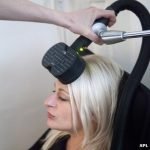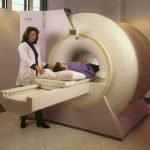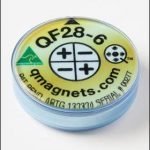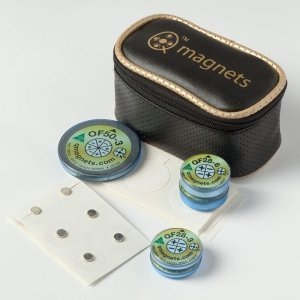The use of magnetic fields is fast developing into a most promising area of medical research. Magnetism is cutting edge in the areas of cardiology (remote magnetic navigation, spatially targeted therapeutics), surgery (reflux management system), oncology (magnetic induction hyperthermia), psychiatry (Transcranial Magnetic Stimulation or TMS), radiology (MRI), pathology (magneto-optic screening) and emerging areas of pain therapy (magneto-neuromodulation), while the use of medical magnets in pain management is gaining credibility amongst medical practitioners.
The principle reason for this magnetic revolution in medicine is science. That is, by testing, validating and refining the optimisation process. Innovation produces more effective technologies and their commercialisation improves the lives of patients. Magnetism in medicine has the added advantage of its non-invasive nature with few side-effects and relatively low-cost. Unfortunately, most people’s concept of magnetic therapy is bipolar magnets in underlays and magnetic jewellery, however these are just a diversion to the real innovation.
Good Medicine program investigates research on Quadrapolar magnets.
Endless Possibilities to Change Treatment Parameters.
Using magnetism as a source in developing new therapies has the added complexity of so many treatment parameters. These treatment “windows” include
- Magnetic field strength
- Frequency for Pulsed EMF
- Alternating pole orientations
- Magnetic field gradients
- Field penetration
- Location of the magnet relative to the target tissue
- Treatment duration
Adjusting the “dose” of any of these parameters can change the effects experienced by the user. In reality, with relatively few clinical trials using static magnets having been completed, this is a field still in its embryonic stages. However, there is abundant anecdotal evidence with case studies, this combined with the promising research already published fuels the expectation of better treatments that will improve people’s lives and make more efficient use of health budgets.
Prior to the discovery of antibiotics in the 1940’s, the therapeutic application of electromagnetic fields was widespread among doctors and in hospitals. New and effective drugs gave birth to the mammoth pharmaceutical industry which now dominates the medical landscape. Innovative designs and treatment methods using magnetic fields is once again a new frontier in medicine.
In the zone is a term commonly used in athletic circles where a focus achieves increased levels of performance. A parallel exists with static magnetic fields, which are said to operate within electrotherapeutic windows. When magnetic field therapy is “in the zone”, the therapeutic effects can be life changing as in the case of John.
The following four examples demonstrate how static magnetic fields can be optimised for therapeutic effects.
Four Areas Where Magnetism is Changing Medicine:
- Magnetic Resonance Imaging
- Deep Transcranial Magnetic Stimulation
- Pulsed Electromagnetic Field Therapy
- Static Magnetic Field Therapy
MRI – The most accurate medical imaging available.
Magnetic Resonance Imaging is at the cutting edge of medical imaging. It uses very strong magnetic fields, strong field gradients and radio waves to produce the most accurate images of the body’s internal structures. Medical specialists order MRI’s when investigating conditions such as tumours, joint, spinal or soft tissue injuries or diseases of the heart or brain which are not visible to x-rays. In fact, the 2003 Nobel Prize in medicine was awarded to Paul Lauterbur and Sir Peter Mansfield for harnessing the combination of magnetic field gradients and radio waves to produce Magnetic Resonance Imaging.
DTMS – Deep Transcranial Magnetic Stimulation.
 DTMS sends magnetic waves through the brain, targeting areas that cause problems such as obesity, obsessive-compulsive disorder, depression and bipolar disorder. While DTMS has been around since the 1980’s, clinical trials are assessing the effectiveness of distinct treatment protocols. Different machines will penetrate to varying depths in the brain while targeting specific areas such as the prefrontal cortex. Other variables include the strength of the magnetic field and the frequency of the pulses and even the duration of treatment and how often over what time frame. Not unlike static magnets for pain, all these variables need to be tested to determine the optimum treatment.
DTMS sends magnetic waves through the brain, targeting areas that cause problems such as obesity, obsessive-compulsive disorder, depression and bipolar disorder. While DTMS has been around since the 1980’s, clinical trials are assessing the effectiveness of distinct treatment protocols. Different machines will penetrate to varying depths in the brain while targeting specific areas such as the prefrontal cortex. Other variables include the strength of the magnetic field and the frequency of the pulses and even the duration of treatment and how often over what time frame. Not unlike static magnets for pain, all these variables need to be tested to determine the optimum treatment.
DTMS is used at famous hospitals such as the Mayo Clinic and Johns Hopkins and everyday articles are published on how it works and its benefits. This is one on Science Daily and a more in depth description from a major hospital’s centre for women’s health.
PEMF – Pulsed Electromagnetic Field Therapy.
Pulsed Electromagnetic Fields (PEMF) vary with time and are said to be pulsed at a certain frequency. These pulsed magnetic fields are generated by running alternating electrical currents through coiled wire. PEMF is used widely in North America and Europe by both humans and animals for fracture healing, pain relief, improved health and athletic performance. A great resource on PEMF is www.drpawluk.com
SMF – Static Magnetic Field Therapy.
Static magnets such as Q Magnets are just that, static and have no frequency since the field does not vary with time. So frequency is one variation that cannot be varied with most static magnets. The magnetic fields from Q Magnets however, do vary spatially (in space) and are said to be inhomogeneous which is the subject of field gradients as discussed above.
Neuromagnetics is at the cutting edge in developing wearable magnets to potentially provide comfort of localized temporary relief of minor aches and pains or the treatment of pain and injury recovery. After thousands of patients treated and numerous clinical trials and animal studies, there is now enough evidence to recommend protocols for effective Q Magnet placement
Magnetic Field Therapy is…
- Simple
2. Drug free
3. Non-addictive
4. Non-invasive
5. Painless
6. Safe
7. An immediate and local impact
8. Performed at home
9. Paid for by the individual and
10. Based on scientific evidence
And by a listed medical device that…
- Does not require any care or maintenance
2. Lasts almost a lifetime
3. Has no moving parts
4. Is relatively inexpensive
5. Consumes almost no energy
6. Is a treatment which requires little expertise, and
7. While not is use can be used to keep notices stuck to the fridge
Why would anyone not seek to support such a therapy?
Corporate and institutional self-interest would like nothing more than to keep magnetism in medicine sidelined as a discredited practice. In fact it does this by engaging in a practicing called astroturfing. Medicine has a long history of being slow to catch on, which is beautifully illustrated in the incredible story of Dr Ignacio Semmelweis. Ignacio was a 19th century Hungarian obstetrician otherwise known as the “saviour of mothers” after discovering women giving birth with the help of doctors had 3 times the chance of dying than those assisted by only midwives and was one of the first doctors to link hygiene with the spread of infection. He made the connection that doctors delivering babies without washing their hands right after giving autopsies could spread infections. How was Dr Semmelweis treated for this life saving discovery? Remarkably, he was driven out of the medical profession and died in an asylum. Who could have believed it would be another 50 years before washing hands between patients became standard clinical practice. Think of the thousands of needless deaths that occurred in just this one instance because new approaches are rejected. Caution should always be shown with new therapies that have the potential to cause harm, but what are the risks of washing hands or for that matter taping a magnet to your lower back?
The legacy of Dr Semmelweis lives on today in the Semmelweis Effect which is a metaphor for human behaviour characterized by reflex-like rejection of new knowledge because it contradicts entrenched norms, beliefs or paradigms.
If you thought this sort of thing couldn’t possibly happen today in a world of instant communication, then spare a thought for Australian Dr Barry Marshall, who discovered that the bacterium Helicobacter pylori caused stomach ulcers. This was at a time when conventional science taught that bacteria could not even exist in the stomach. Twelve years after his discovery with no recognition, Dr Marshal resorted to infecting himself with the bacteria to bring on stomach ulcers and quickly cure himself with antibiotics. The time-lag reflects, as Professor William Doe of the Australian National University comments, “how difficult it is to change medical paradigms because everyone has a vested interest in the status quo”. The pharmaceutical industry held the biggest vested interest in ulcers. Two of its biggest all-time earners had been the acid suppressing drugs cimetidine (Tagamet) and ranitidine (Zantac). These drugs did not cure ulcers, meaning patients often needed lifelong therapy. It was only after the drug companies were able to convince educators and policy makers that their drugs should remain an important part of the therapy that Dr Marshal’s theories were taken seriously. The similarities between stomach ulcers and pain are striking if not magnified.
Since research on SMF therapy in humans is still emerging, it is vital that the proper foundations are laid for future clinical trials. A fundamental concept in methodology is the assurance that optimal SMF dosage and treatment parameters are established for each clinical condition under study. If the applied SMF is of insufficient strength to reach its target or if the frequency or duration of application is inadequate for the medical condition under investigation, trial results might be invalid or misleading. Such a situation could be likened to conducting a trial to evaluate the effectiveness of the antibiotic doxycycline for treating Mycoplasma pneumonia. If patients in the study are given a single 100 mg dose of the antibiotic, the results might show no significant improvement. It would, however, be erroneous to infer from this result that doxycycline is ineffective for treating Mycoplasma pneumonia.
Now with the miniaturisation of magnets, the development of superconducting electromagnets and the introduction of much more powerful rare-earths such as neodymium magnets, new frontiers in magnetism in medicine are developing.
REFERENCES:
Andra, W. and H. Nowak (2007). Magnetism in Medicine: A Handbook. , Wiley-VCH.
Colbert, A. P., H. Wahbeh, et al. (2009). “Static magnetic field therapy: a critical review of treatment parameters.” Evid Based Complement Alternat Med 6(2): 133-139. PMID 18955243; doi:10.1093/ecam/nem131
McLean MJ, Engstrom S, Holcomb RR (2003) Magnetotherapy: Potential Therapeutic Benefits and Adverse Effects. The Floating Gallery








